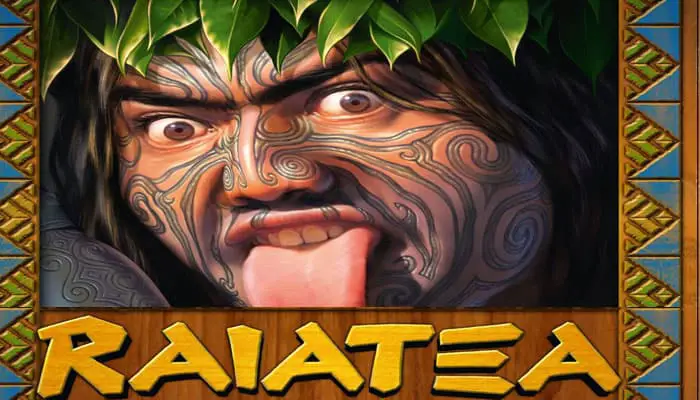
Components

- 1 Game Board
- 6 Location Tiles
- 5 Player Screens
- 92 Ritual Cards
- 1 Sacrifice Bag
- 15 Ritual Clips
- 68 To'o Mission Tokens
- 10 Player Discs
- 1 Game Round Marker
- 4 Price Markers
- 5 Ritual Cubes
- 72 Forest Cards
- 1 Die
- 1 Starting Player Token
- 25 Pearls
- 50 Mana Tokens
- 36 Starting Cards
- Instructions
Object of the Game
In Raiatea, players act as members of the Arioi, a secret Polynesian religious society. Over the course of the game, the Arioi will build colossal To'o statues in attempt to win the favour of their god, Oro.
In the game's action rounds, players will take turns leading the group to various action locations. In ceremony rounds, players will call upon the gods for help in building the massive To'o.
Construction may fail without these gods' help, so players must plan their Rituals carefully and know how much Mana to sacrifice in order to accomplish their goals. At the end of the game, the player who has collected the most victory points will guide the group as their new High Priest!
Setup
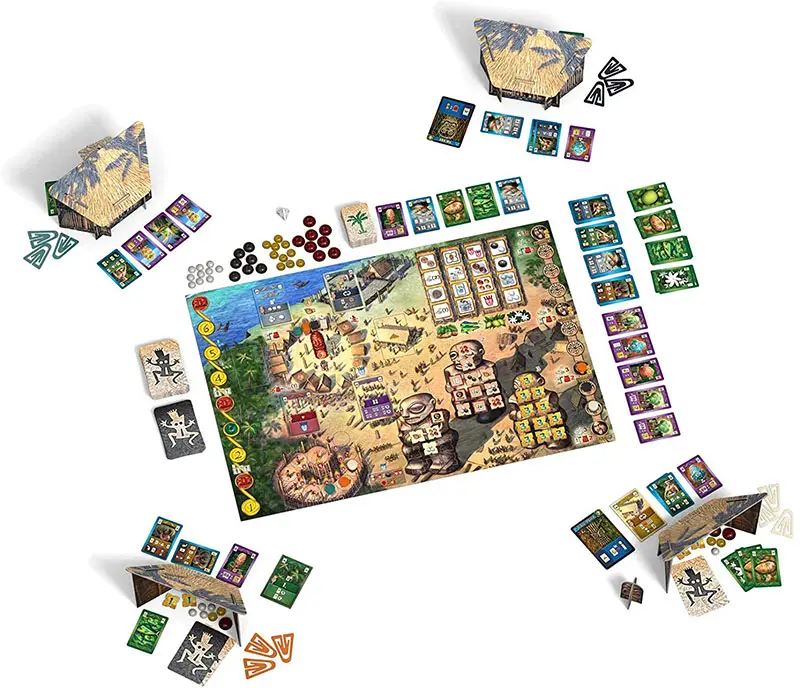
-
Give each player the Player Discs, Ritual Cube, Ritual Clips and Player Screen of his or her chosen color. Then, give each player 5 Mana and 4 Pearls; these are kept hidden behind each Player Screen. Place the remaining Mana and Pearls as general supply next to the Game Board.
-
Randomly determine a starting player and give that person the Starting Player Token. Beginning with the starting player, the game will proceed in a clockwise direction.
-
Place the Location Tiles on the matching spots of the game board.
-

Sort the 24 Starting Assistant Cards by type and place them next to the game board; this is the Assistant Market.

-

Place the 4 Starting Commodity Cards next to the Assistant Market; this is the Commodities Market.

-
Place a Price Marker on the second space of each Commodity's Price Chart.
-

Shuffle the 8 Starting Mask Cards and randomly deal 1 to each player; these are displayed in front of players' screens. The remaining Starting Mask Cards will form the Mask Market.

-

Shuffle the Forest Cards into a draw pile, then form the Forest Supply by flipping over a number of Cards equal to the number of players, plus one.

-
Each player places a Player Disc on the space marked "Raatira;" these are their Tattoo Markers.
-
Turn the To'o Mission Tokens so that the sides showing victory points (VP) are face-up. Assign the 1 VP tokens to Statue 1, the 2 VP tokens to Statue 2, and the 3 VP tokens to Statue 3.
Then, turn over all To'o Mission Tokens on Statue 1. Return any unused tokens to the box; they will not be used in this game.
-
Each player places a Player Disc on the "0" space of the Priest Track, as a Priest Marker.
-
Place the Game Round Marker at the bottom of the Round Track.
-
Place the Sacrifice Bag to the side of the game board.

-

Shuffle the Normal Ritual Cards into a draw pile.
Each player now draws 5 of these Cards and chooses 2 of them to keep behind his or her Player Screen. Cards not kept by players should go into a discard pile.
- In a 4-player game: Player 1 keeps only 1 Ritual.
- In a 5-player game: Player 5 will repeat this process (drawing another 5 Rituals and keeping 2, so that he or she has a total of 4 Rituals).
-

Shuffle the Forbidden Ritual Cards into a draw pile and place them next to the game board.
-
Place players' Ritual Cubes on the spaces of the Ceremonial Site. These should be placed in player order, from left to right (the first player's cube should be on the leftmost spot).
Game Play
Raiatea is played over the course of 3 ceremony rounds and as many as 6 action rounds. The game will end after the third ceremony round.

- 3 players: 6 action rounds
- 4 players: 5 action rounds
- 5 players: 4 action rounds
A. Action Round
The starting player begins by choosing a Location Tile from the game board and placing it in front of his or her screen.
Each location has an action that can be taken by all players, as well as granting a bonus for the player who claimed that location. That player is called the Kahuna; Kahuna bonuses are indicated by  . Some locations require a die to be rolled; the Kahuna is the player who rolls the die.
. Some locations require a die to be rolled; the Kahuna is the player who rolls the die.
Once all players have performed the actions of the first location, the next player claims one of the remaining locations and the process is repeated with new actions and a new Kahuna.

Once each player has claimed a Location Tile, the current game round ends and the players prepare the next one:
-
Pass the starting player token one seat to the left.
-
If any Forest Cards remain face-up, add them to their respective Markets (Commodity, Assistant, Mask). Reveal a number of new Forest Cards equal to the number of players, +1.

-
Return all Location Tiles to the game board.
-
Advance the Game Round Marker by 1 space. If the next space is yellow, a new action round begins. If the next space is red, the game proceeds to a ceremony round.

Once the Game Round Marker has reached the last space marked with the number of players, there will be no further action rounds after this round.
With 4 players, skip action round 6. With 5 players, skip action rounds 5 & 6. After this, you will proceed to the last Ceremony round of the game.
Golden Rules:
The Kahuna is always the first to perform an action, followed by other players in turn order.
Each player must choose a location.
Players are NOT required to perform a location action, nor are they required to use a Kahuna bonus.
Location Tiles remain in front of players' screens until the end of the round.
The different action locations:

Forest
Obtain Forest Cards
Starting with the Kahuna and going in clockwise order, each player chooses one of the Forest Cards on display. When only one Card remains, add it to the appropriate Market.
Then, reveal new Forest Cards (equal to the number of players + 1). The Kahuna again chooses first, but now selection will now proceed counterclockwise.
Resolving Forest Cards:
-

Masks: The player places his or her chosen Mask Card in front of his or her screen. Masks may provide treasure (Pearls or Mana) or allow a player to advance his or her Tattoo Marker.
Mask treasures should be taken from the general supply and placed behind the player's screen.
-

Commodity: The player places the chosen Commodity Card behind his or her screen.
-
Assistant: The player places the chosen Assistant Card in front of his or her screen.
Note: If you are unable to refill the Forest Supply during this action, use Commodity Cards from the Commodity Market. Leave one Commodity Card of each type in the Commodity Market, then shuffle the rest and use them as a new draw pile.
 Kahuna bonus: The Kahuna always chooses a Forest Card first.
Kahuna bonus: The Kahuna always chooses a Forest Card first.

Marae
Get Tattoos and Ritual Cards
Sacrifice Commodities
Here, each player may sacrifice (return to the market) one Commodity Card from their hand; a player that does so may advance his or her Tattoo Marker by 1 space.
If a player's Tattoo Marker ends its movement on a space with a new rank (Ariki, Arioi, or Tahua), that player may immediately use the new rank's ability. Upon attaining the rank of Tahua, a player may immediately play any one Ritual from his or her hand, for free. This is a one-time bonus.
Draw Ritual Cards
Each player may draw 3 Normal Ritual Cards. A player who does so will keep 1 of those Cards behind his or her screen and discard the other 2 onto a pile next to the Ritual stack. Note that higher ranks change the rules for drawing Ritual Cards:
- Ariki: May draw 3 Normal OR 3 Forbidden Rituals, and keep one.
- Arioi and Tahua: May draw 5 Normal OR 5 Forbidden Rituals, and keep one.

Kahuna bonus: The Kahuna may sacrifice an additional Commodity Card from his or her hand to advance his or her Tattoo Marker by 1 space and draw an additional set of Ritual Cards (according to his/her rank) and keep 1.

Example: Arno chooses the "Marae" location. He adds one Mahi-mahi and one Taro to the Commodities Market and advances his Tattoo Marker by 2 spaces (1 for the sacrifice, plus 1 for his Kahuna bonus).
His marker lands on the "Ariki" space, allowing him to immediately use the Ariki's ability. He first draws 3 Normal Ritual Cards and keeps 1 of them. His Kahuna bonus allows him to draw another 3 Ritual Cards.
This time, Arno draws 3 Forbidden Rituals, keeping one of these in addition to the one kept from his previous draw.

Pearl Oyster Reef
Dive for Pearls
The Kahuna rolls the die; each player receives Pearls equal to the result. This die roll is in addition to the roll made to determine the bonus from Pearl Diver Assistants.
 Kahuna bonus: The Kahuna receives an additional 3 Pearls.
Kahuna bonus: The Kahuna receives an additional 3 Pearls.

Path of the Gods
Recruit Priests and Gain Mana
Here, players may pay Pearls to recruit up to 2 Priests. Two Pearls recruit 1 Priest; 5 Pearls will recruit 2 Priests.
The number of Priests recruited is also the number of spaces a player will advance his or her Priest Marker. Finally, each player gains an amount of Mana equal to his or her location on the Priest Track.
 Kahuna bonus: The Kahuna recruits an additional Priest for free.
Kahuna bonus: The Kahuna recruits an additional Priest for free.
 2 Pearls = 2 Priests
2 Pearls = 2 Priests
 5 Pearls = 2 Priests
5 Pearls = 2 Priests
 You receive 1 Mana for each Priest you recruited.
You receive 1 Mana for each Priest you recruited.

Example: Max (black), Rafael (teal) and Maria (orange) each have 3 Priests. Max pays 5 Pearls and recruits 2 Priests; he advances his Priest Marker accordingly.
Max now has 5 Priests, and he gains 5 Mana. Rafael and Maria don't pay any Pearls, and thus their Priest Markers stay at 3. They each gain 3 Mana.

Neighbourhood
Exchange Masks
In the Neighbourhood, all players may add one of their Masks to the Mask Market.
Then, starting with the Kahuna and proceeding clockwise, each player who has added a Mask to the Market may take a Mask from that Market and place it in front of his or her screen. This exchange of Masks does not generate treasure!

Kahuna bonus: The Kahuna may fulfill a face-up To'o Mission by paying the required resources or meeting the required condition.
Tokens from To'o Missions are kept behind players' screens.

Players add Masks to the Mask Market in turn order and then take an available one, again in turn order.

Market
Sell Commodities and Hire Assistants
Starting with the Kahuna and going clockwise, players may sell Commodities and hire Assistants. The active player may perform these actions in any order he or she chooses.
Selling Commodities
A player may sell one Commodity by returning a Commodity Card to the Commodities Market. That player chooses any one bonus at or below that Commodity's Price Marker, then moves the Price Marker one space downward.
General Rule Regarding Price Markers
Each time a Commodity is added to the Commodities Market (in any game phase), that Price Marker is moved down one space.
Each time a Commodity is taken from the Commodities Market, that Price Marker is moved up one space. A marker on the top space cannot be moved up any further, and a marker on the bottom space cannot be moved down any further.
Do not adjust Price Markers if Commodity Cards are taken to form a new Forest draw pile.
Hire Assistants
A player may hire one Assistant from the Market. An Assistant costs 2 Pearls and is placed in front of its owner's Player Screen.

Kahuna bonus: The Kahuna may sell one additional Commodity and may pay to hire one additional Assistant.

Hire one Assistant for 2 Pearls. The Kahuna can hire two Assistants.
B. Ceremony Round

When the Game Round Marker reaches a red space, a ceremony takes place. Ceremony rounds offer players the opportunity to build To'o statues and perform Rituals they have collected during the previous action rounds.
A ceremony round consists of six steps, which are performed in the order described below. Players perform each step simultaneously.
-
The Dance of the Priests

Each player may pay 2 Pearls to recruit 1 Priest, or 5 Pearls to recruit 2 Priests. Then, each player gains 1 Mana for each of their Priests.
This step is identical to the "Path of the Gods" action, minus the Kahuna bonus.
-
Buy Ritual Cards
Each player may put 3 Mana into the Sacrifice Bag and draw a number of Ritual Cards according to their rank, keeping one.

-
Preparation of Rituals

Each player chooses up to 2 of their Rituals (up to 3 if they have reached the rank of Arioi or Tahua) and attaches one of their Ritual Clips to each; these Rituals are then put into the Sacrifice Bag.
The other players must not see which Rituals a player puts into the bag. Players may carry this process out simultaneously, or in any order.

Important rule regarding Brown (General) Rituals:
Brown Rituals trigger common effects. They are put into the Sacrifice Bag without a clip and in addition to the rituals marked with a player's clip.
-
Incantation of the Gods
Step 1: Mana Offering

In this step, players will offer Mana in exchange for the gods' favor. This is done through bidding, as follows: each player conceals any amount of their own Mana in a closed fist, held above the game board.
Once all players have done so, everyone opens their hands to reveal how much Mana was offered. Arrange players' Ritual Cubes on the ceremonial site in descending order (whoever offered the most Mana occupies the "1" space, whoever offered the next greatest amount takes the "2" space, and so on).
In case of a tie, the relative player order prevails. This is the ceremonial player order. All offered Mana is put into the Sacrifice Bag.
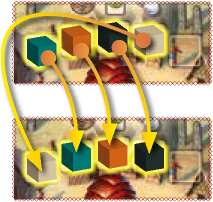
Example: In a four-player game, the current ceremonial player order is Rafael (teal), Maria (orange), Max (black), and Arno (grey).
They each conceal a secret amount of Mana in their hands, then simultaneously reveal their bids. Rafael bid 7 Mana, Maria and Max each bid 4, and Arno bid 8.
Arnos Ritual Cube moves to the 1st position in the ceremonial player order, and Rafael's Ritual Cube moves to the 2nd position. Maria and Max each bid 4 Mana, so their positions relative to each other remain the same.
Maria's Ritual Cube moves to 3rd position, and Max's moves to 4th.
Step 2: Assignment of ceremonial gifts
The player in first position (who had offered the most Mana in the previ- ous step) is the first to choose one of the following three gifts:
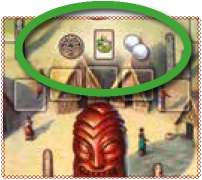
 1 Tattoo.
1 Tattoo. 1 Commodity from the Commodities Market.
1 Commodity from the Commodities Market. 2 Pearls from the general supply.
2 Pearls from the general supply.The player in second position chooses one of the two last gifts, and the remaining gift will go to the player in third position. In a three-player game, no one receives the third gift.
The 4 Types of Ritual Cards:
All Rituals (Normal and Forbidden) belong to one of four different types:
-

Personal Rituals (Black): have immediate effects on the owner.
-

Permanent Rituals (Blue): have persistent effects and are placed in front of the player's Screen.
-

Interactive Rituals (Burgundy): have immediate negative effects on other players.
-

General Rituals (Brown): have immediate general effects on ALL players. Ritual Clips do not need to be placed on these cards.
-
-
Receive the Divine Blessings

Take all Mana and Ritual Cards out of the Sacrifice Bag. Arrange the Rituals on the table in ascending order of Mana cost (seen in the cards' top right corners).
If there are Rituals of equal value, sort them according to ceremonial player order (see step 4).
If two or more Rituals of equal value belong to the same player, that player decides which of those Rituals will be performed first. General Rituals are always placed before any others of same cost.
Then, perform Rituals as described below until all offered Mana has been exhausted or all Rituals have been performed:
If there is enough Mana to activate the leftmost (least expensive) Ritual: return the Ritual's Mana cost to the supply and apply the effect of the Ritual. Discard the completed Ritual or, if it was a blue Ritual, place it in front of its owner's screen.
If there is not enough Mana to activate the leftmost Ritual, discard all remaining Rituals; do not apply their effects. Return any leftover Mana to the Sacrifice Bag and return all clips to their owners.
-
The Ceremonial Construction of the To'o

In ceremonial player order, each player may fulfil one available To'o Mission as displayed on the statues.
This is typically done by paying required resources or meeting a required condition. If you are unable to fulfill a Mission, or do not wish to do so, you must pass your turn.
Once all players have had the chance to fulfill one Mission, repeat the process until all players have passed. Tokens from fulfilled To'o Missions are kept behind players' screens.
End of the Ceremony
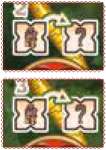
After the first Ceremony Round, reveal the To'o Missions on the second statue. After the second Ceremony Round, reveal the Missions on the third statue. In either case, advance the Game Round Marker by 1 space.
If this was the third ceremony round, the game is over and final scoring can take place.
To'o Missions
There are three ways in which players can fulfil To'o Missions: as the Kahuna at the "Neighbourhood" location, by selling Mahi-mahi at the Commodities Market (if the Price Marker is at the top spot), or during a ceremony. There are 3 types of To'o Missions:
-
Resource Missions
These require the player to discard the depicted resources (Pearls, Mana, Commodities, Masks).
-
Conditional Missions
Conditional Missions are those that require a player to meet a certain condition, such as having attained a certain rank, having a certain number of Priests, or a certain number of Assistants.
They are clearly marked by a dark red border. The player must satisfy the depicted condition. For example, if a player wants to fulfill (and take) the "6 Priests" Mission, he or she must simply have recruited at least 6 Priests.
When fulfilling a conditional Mission, the player does not have to discard or pay for anything. A Mission Token's requirements may only be fulfilled once.
-
Mana Auction Missions
Mana Missions marked with
 are auctioned as soon as there are no other types of Mission left in that row.
are auctioned as soon as there are no other types of Mission left in that row.If there is more than one
 Mission in the row, auction each one separately (these auctions are not considered to be a turn). When To'o Missions are revealed after a ceremony round, an Auction Mission token may be found to occupy a single-space row.
Mission in the row, auction each one separately (these auctions are not considered to be a turn). When To'o Missions are revealed after a ceremony round, an Auction Mission token may be found to occupy a single-space row.Such a token will be auctioned at the very beginning of step 6 of the next ceremony round. Players bid by concealing any number of their own Mana tokens in their hands and then holding their closed fists above the game board.
The players reveal their bids simultaneously; the player who has offered the most Mana successfully fulfills that Mission. Resolve ties in favor of the player who is earliest in ceremonial player order.
Regardless of who won the auction, ALL players must then put all bid Mana into the Sacrifice Bag.
Assistants
All Assistants have a permanent effect A and a "one-time" effect B . The following general rules apply for Assistants:
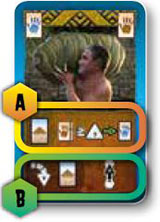
Whenever you obtain an Assistant, place it face-up in front of your Player Screen.
Each Assistant's "one-time" effect may be used once per game. After using such an effect, turn that Assistant 90° to indicate that it may not be used again in this game unless reactivated through the Market or certain Rituals.
Used Assistant Cards always retain their permanent effects.
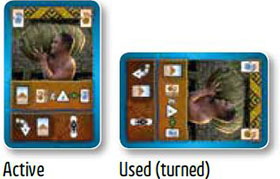
-

Collector:
AWhen visiting the Forest, the Kahuna rolls the die before any actions are resolved.In turn order, all players owning a number of Collectors equal to or greater than the result of the die roll may take one Commodity Card from the Commodities Market.
Adjust selected commodities' Price Markers up by one step for each card taken.
BWhen it is a player's turn to select a Forest Card, he or she may activate one Collector in order to add a Forest Card to the Forest Supply. Then, that player chooses a Forest Card as Normal, plus a Commodity Card from the Forest Supply.If no Commodity Cards are present in the Forest Supply, this bonus is lost.
In a game with 3 players, there are 4 Forest Cards on display. It's Arno's turn, and he chooses the Forest location tile. As the Kahuna, he goes first and decides to use one of his Scouts.
Arno draws a card and adds it to the Forest Supply, from which he selects a Mask and a Mahi-mahi Because this card was taken from the Forest Supply, the Mahi-mahi Price Marker does not move.
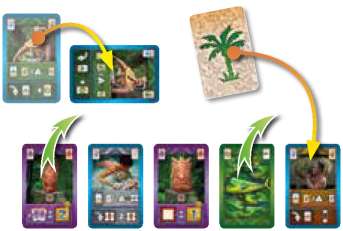
-
Merchant:
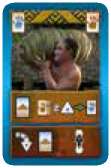
AWhen visiting the Marketplace, the Kahuna rolls the die before any actions are resolved.All players owning a number of Merchants equal to or greater than the result of the die roll may take one Assistant of their choice from the Assistant Market.
BA player may activate one of his or her Merchants to move a Commodity Price Marker to the top space of its Price Chart. A hired Merchant may be used immediately. -
Shaman:

AWhen visiting the Marae, the Kahuna rolls the die before any actions are resolved. All players owning a number of Shamans equal to or greater than the result of the die roll may advance their Tattoo Markers by 1 space.BPlayers may activate one or more of their Shamans during their own turns (action round and/ or ceremony round) to perform Rituals they own (one Ritual per Shaman). The Mana costs of each of these Rituals must be equal to or less than the number of Priests a player has recruited. -
Pearl Diver:
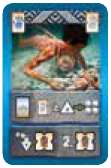
AWhen visiting the Pearl Oyster Reef, the Kahuna rolls the die before any actions are resolved. Each player owning a number of Pearl Divers equal to or greater than the result of the die roll earns 4 Pearls.BWhen fulfilling a To'o Mission, you may activate one Pearl Diver to fulfil a second Mission (NOT a third or more). The required resources must be paid as usual.
End of the Game
The game ends after the third ceremony round. The players now add up all their victory points as follows:
1. Victory Points Gained By Rank:
Players receive victory points (VP) according to rank. Ariki earn 3 VP, Arioi earn 6 VP, and Tahua earn 9 VP.
 VP are awarded according to rank. |
2. Victory Points Gained from Rituals:
The Papa-Ra'i Forbidden Rituals generate VP. A player with such Rituals adds the appropriate amount of VP to his or her total.
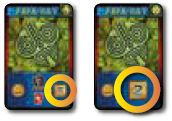 Some Forbidden Rituals provide VP. |
3. Victory Points from To'o Missions:
Fulfilled To'o Missions give 1-3 VP, as indicated on the reverse sides of the To'o Mission Tokens.
 Fulfilled To'o tokens provide VP. |
4. Victory Points from Masks:
All Masks exist in pairs. If a player manages to collect both Cards of the same pair (i.e., two Cards sharing the same image), that player will gain additional VP.
Note: paired Mask Cards cannot be stolen by the use of Forbidden or Interactive Rituals. Depending on the Mask, extra VP may be awarded for various achievements. These include:
- Collected To'o Missions (Pearls, Mana, Commodities, conditional)
- Hired Assistants (Collectors, Merchants, Shamans, Pearl Divers)
- Collected pairs of different types of Masks
Masks can only be scored if you have a matching pair. Unpaired Masks are not worth any points at the end of the game. Masks are scored per pair, and NOT once per card.
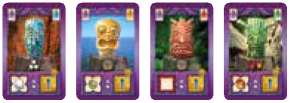
These Masks give +1 VP for each of your To'o Mission Tokens of the type depicted.
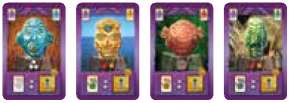
These Masks give +1 VP for each Assistant you have of the type depicted.
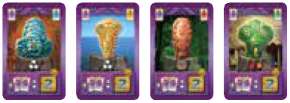
These Masks provide +2 VP for each differently- colored pair of Masks you own, to a maximum of 8 VP each.
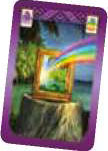
Rainbow Mirror Cards are wild. On a player's turn, he or she may match a Mirror to one of his or her Masks. A Mask matched to a Mirror is considered to be paired and complete, and will generate VP accordingly.
Once attached to a Mask, a Mirror cannot be released from the pair even if the player obtains that Mask's "actual" matching Card. Rainbow Mirrors may not be paired to each other.
The player who has collected the most victory points is the winner.
If there is a tie, it is resolved in favour of the tied player who is earlier in ceremonial order.
Some Tactical Hints for Beginners
It is a good idea to visit the Forest frequently.
Although fulfilling To'o Missions generates victory points, players should not put all their efforts into con- struction, particularly in the early stages of the game.
Instead, we recommend that you improve your status through the achievement of better rank, more Assistants, and more Priests.Rank is useful for more than VP, as higher ranks provide greater options. We strongly recommend that you strive to achieve the rank of Ariki as soon as possible, as this will allow you to perform Forbidden Rituals.
Advanced Rules (optional)
Tane Game

Experienced players may opt to add the Tane Rituals to their game, as long as they are prepared for some nasty surprises.
These interactive Rituals allow players to steal from each other, remove opponents' Priests, or prevent certain Rituals from being performed.
Oracle Game

For players who like to plan ahead, you may choose to play with all To'o Missions tiles from statues 2 and 3 revealed at the start of the game.
The construction of statues 2 and 3 may only be initiated after the first and second ceremony rounds, respectively, and per the usual rules.
Mana Shortage

If the players want more Rituals to fail, they may try this variant: when buying Rituals and fulfilling the Mana Auction Missions, return the Mana to the general supply instead of putting it into the Sacrifice Bag.
Continue Reading
